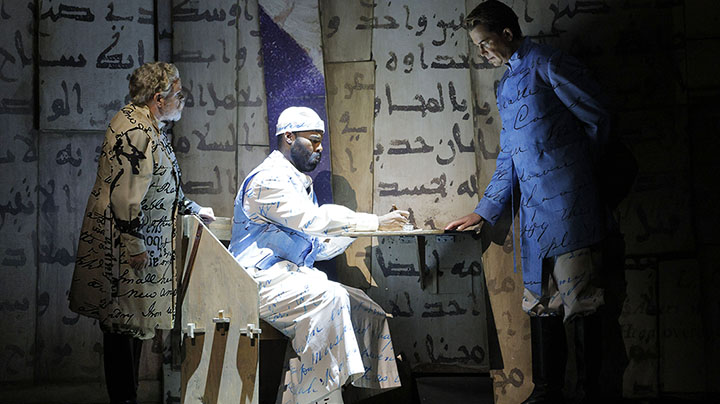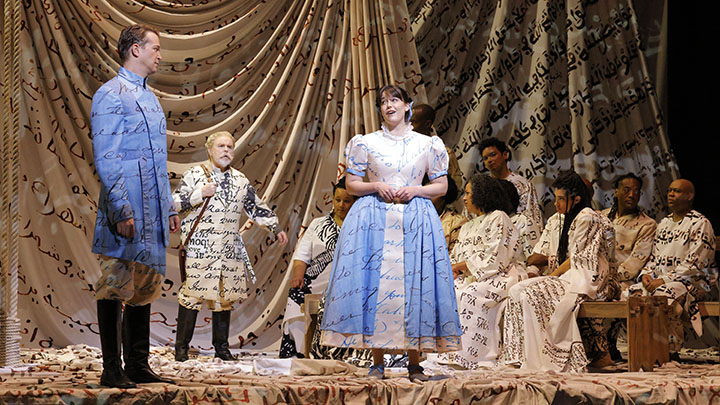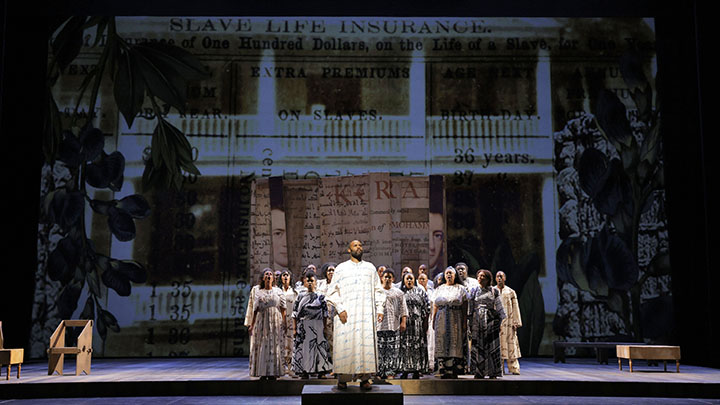
Such was the story of Omar, a new opera by Rhiannon Giddens and Michael Abels (with libretto by Giddens) that received its Bay Area Premiere on Sunday November 5th in a sold-out performance. Co-commissioned by Spoleto Festival USA, Carolina Performing Arts, San Francisco Opera, LA Opera, Lyric Opera of Chicago, Boston Lyric Opera and Detroit Opera, it received its world premiere on May 27, 2022 at the Spoleto Festival before traveling to LA, North Carolina and Boston. It subsequently won the 2023 Pulitzer Prize for Music on May 8 this year, and this marked its first showing since winning the prestigious award!
Omar was inspired by the true story of the 19th century Islamic scholar Omar ibn Said, who was taken from his home in 1807, brought to America through the Middle Passage and sold into slavery in South Carolina. Despite the hardship, ibn Said managed to author fourteen manuscripts in Arabic, including his 1831 autobiographical essay, The life of Omar ben Saeed, called Morro, a Fullah Slave in Fayetteville, N.C. Owned by Governor Owen. That autobiography, the only known slave narrative written in Arabic, was key to understanding ibn Said’s life; he was born around 1770 in the Futa Toro region (now part of Senegal) to a wealthy family of Muslim Fulbe ethnic group and a scholar of Qur’an, the sacred book of Islam, for 25 years before his capture. He landed in Charleston, was sold to a cruel master named Johnson before escaping to Fayetteville, NC and spent the rest of his life in servitude to James Owen till his death in 1864.
In the program, Abels detailed how he and Giddens developed the musical landscape for Omar:
“Omar is the story of one man’s physical and spiritual journey, as told from veiled references in his own autobiography and interpreted through Rhiannon Giddens’ moving libretto. Musically, the piece shows as many influences as the many cultures it flows through, from the music of Senegal and the broader Muslim diaspora to the earliest melody transcribed from enslaved people in North America, to spirituals, bluegrass, Protestant hymns, Gershwin, and even a touch of Wagner. The chorus plays a prominent, active role in the work, as a way to center it in a Black community that is multifaceted and real. These diverse elements are unified via the use of a traditional orchestral palette and immensely singable vocal lines.”
Personally, his first sentence above aptly described the structure of Omar. Structured in two acts with a nearly identical five scenes and 70 mins runtime each, both acts explored Omar’s struggles: his physical struggles in Act I and his spiritual ones in the final act. Act 1 moved in quick succession from his time as a Qu’ran scholar in Futa Toro to the Middle Passage to Charleston Slave Market and finally to Johnson plantation and culminating in his escape; each scene was designed to depict his physical and emotional hardships and confusions, rather than to describe what actually happened to him. In great contrast, Act II progressed in much slower pace as the actions happened only in Fayetteville County Jail and in Owen plantation for the rest of the opera, and the mood turned somber and introspective as pretty much the whole Act II dealt with Omar’s purported conversion to Christianity.
Mark Burford said it best on this subject in the program: “Thinking of Omar as an exploration of poly-religious worldview brokered by the written word helps us make sense of how two themes – the talisman-like significance of Omar’s Arabic literacy and the slippery historical question of his conversion from Islam to Christianity – drive the opera. … [T]he enslaved Muslim’s autobiography and the opera’s production both suggest how Omar’s canny manipulation of Christian dogma to affirm his Muslim faith through the power of the word—as Arabic script and as Islamic scripture—perhaps represents another form of freedom and leads us toward a revised understanding of history.”
The opera’s position as Burford mentioned was exemplified magnificently in the opera’s pièce de resistance: amidst a thick Arabian orchestral sound Omar sang an aria set to Psalm 23 (his 11 o’clock number, to borrow a term from musical theater) and transformed the verses into his own suffering, giving a harrowing twist to the concluding verse “I will dwell in the house of the Lord forever.” While the real-life ibn Said died in enslavement, the “freedom” mentioned above was greatly felt in the final scene, where Omar pronounced “I am Omar. I love to read the book, the Great Qur’an”, ending the opera on an exhilaratingly high note! Seen in that lens, the opera served its purpose as a depiction of triumph over physical and spiritual struggles, although I could definitely see some of the audience might miss the storytelling aspects of the opera.
Sonically, the score of Omar represented a rich tapestry of world music associated with Black communities as described by Abels above. In a way, the whole opera almost felt like a giant musical travelogue chronicling Omar’s journey. In Act 1, the score was dominated by highly syncopated and percussive rhythm, inspired by West African kora, and it progressed and transformed in relentless propensity as if to match the story. (Giddens and Abels employed no less than four types of drums in the score: tar, ghaval, djembes and talking drum.) Act 2 constituted a tonal shift musically as spirituals and church-like hymns populated the score. In general, the score moved the story well and provided a great asset to the opera, with probably a few exceptions in Act 2; the overly “happy” song of Owen’s slaves welcoming Omar’s arrival sounded pretty cringeworthy, and the Show Boat-inspired Owen’s daughter’s song (while sang beautifully by Laura Krumm) felt unnecessary.
On Sunday, Omar arrived at War Memorial Opera House in a pretty much flawless production directed by Kaneza Schaal and designed by Christopher Myers. This was one of those productions that looked and felt like enormous respect and dedication had been given by the creative team to the composers and, essentially, to the story. In fact, Myers’ design, working closely with set designer Amy Rubin and costume designers April M. Hickman and Micheline Russell-Brown, completed the essential triad of presentations for the opera, the visual aspects. In his illuminating blog, SF Opera General Director Matthew Shilvock elaborated this point further: “In projections (designed by Joshua Higgason) , on scenery (designed by Amy Rubin) and on costumes, we see Omar’s written word in a number of forms—in Maghrebi Arabic (a west African form), in English, and in his own drawings. We also see the hand of another enslaved Islamic scholar, Sheikh Sana See.” The appearance of written words and drawings throughout the opera gave a constant reminder that Omar was, first and foremost, a scholar that was thrown into situation beyond his control.
Personally, Schaal and Myers’ greatest achievements were the simplicity and elegance of the look and feel of the production, and the creativity employed to achieve such effects. The stage was practically built upon printed fabrics and cotton ropes in all kinds of shapes and configurations. Of particular interests were the stunning Fatima’s “costume” during Act 1 dream sequence (inspired by Grace Jones’ famous 1986 music video I’m Not Perfect (But I’m Perfect for You)) and the beautiful and gigantic “Tree of Life” in the final scenes, a perfect set piece to showcase Omar’s finding his voice. If I might nitpick, a couple of Joshua Higgason’s projections for the final scene, especially that showed more recent current affairs, felt a bit out of place and, honestly, rather distracting!
San Francisco Opera assembled a handsome cast to bring out the story of Omar to life, and collectively they excelled tremendously. The opera was essentially an ensemble piece, and the camaraderie and rapport among the cast shone through and elevated the performance, even if many were making the house debuts and/or role debuts.
In the title role, tenor Jamez McCorkle was undoubtedly the star of the show. McCorkle, who originated the role at Spoleto Festival and had performed it in each presentation of Omar to date, imbued the character with a dignified presence and an authoritative air, stoic and heroic like an unassailable rock. In this production, McCorkle bookended the show by “assuming” the role (aka changing into the clothes of Omar), similar to the last Broadway revival of Fiddler on the Roof starring Danny Burstein. McCorkle, who practically never left the stage throughout the opera, fully embodied Omar’s persona, and his slightly dark timbre contrasted well with Owen and Julie in their duets correspondingly. McCormick’s voice also easily soared over the thick orchestral sound, particularly in that climactic Psalm 23 aria.
In her spectacular house and role debut, soprano Brittany Renee provided a much-needed female counterpart to the story as Julie, an enslaved woman at Owen’s plantation and Omar’s confidante. Gorgeously and effortlessly sang, her Julie was marked with a sense of strength and kindness, and gave the opera some respite from all the heaviness (of the story), particularly in her funny banter with Katie Ellen in Act II. Renee was particularly mesmerizing in her Act II aria (“My Daddy wore a cap”) where Julie disclosed that her father was a Muslim like Omar; Renee’s bright voice suggested child-like and naiveté despite the tragic nature of the aria.
Taylor Raven sang the role of Fatima, Omar’s mother and his conscience, with a calm and earnest manner while bestowing wisdom on Omar through dream sequences. (It was interesting to note that all three SF Opera contemporary operas this year featured such characters!) While Raven sounded warm and noble, it was unfortunate that at times her voice got drowned by the orchestra and the chorus, particularly during climaxes. On the other hand, baritone Daniel Okulitch impressed as he flexed his acting muscle in the dual roles of Johnson, the “bad” master and Owen, the “good” master. Okulitch varied his tones in his characterizations; hard and unforgiving as Johnson, warm and kind as Owen (albeit with slightly dark undertone when he thought Omar gave allegiance to “a False God”). Similarly, tenor Barry Banks assumed the dual roles of the cruel Auctioneer and friendly Taylor, Owen’s friend.
The comprimario roles were all handled effectively, with special shoutout to baritone Norman Garrett as Omar’s brother Abdul and Rehanna Thelwell as Katie Ellen. John Keene assembled a chorus of 32 African-American singers and they performed splendidly as either Senegalese villagers or freed and enslaved people.
John Kennedy, who also conducted the world premiere in Spoleto Festival, made the house debut leading these performances. In his hands, Giddens and Abels’ score came alive, with brisk tempi (particularly in Act I) and exciting accents, particularly in the percussion sections. Kennedy navigated the ever-changing musical influences and styles smoothly and with steady hands guided the orchestra in a continuous forward momentum. He managed to keep the integrity of the score intact even with the major focus change between the acts. I only wished he would be a little bit more sensitive with the singers during some climaxes, but it was probably hard to do with so many people on stage!
Omar marked another triumphant new commission by San Francisco Opera, and it was heartening to see the audience flocked to War Memorial on its Opening Night! There are only four more performances of this heartbreaking and thought-inducing production, with the next performance on Saturday November 11 7.30pm PT will be livestreamed and it will be available to watch on demand for 48 hours beginning on the following day at 10am!
Photos: Cory Weaver/San Francisco Opera




























Comments